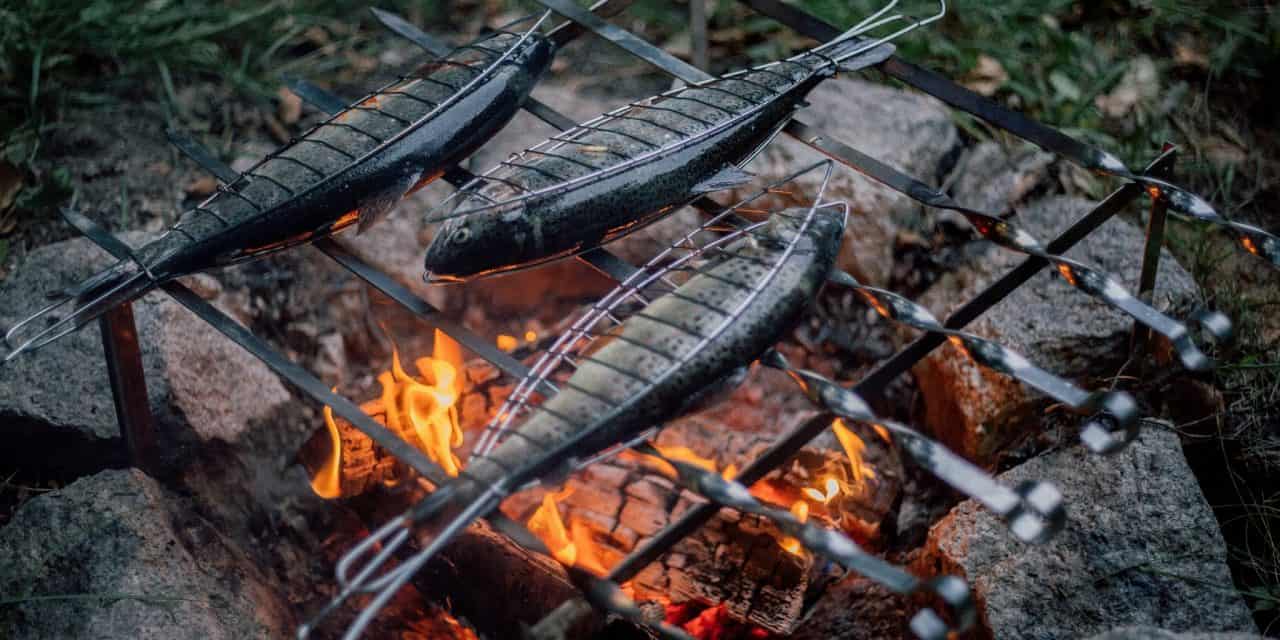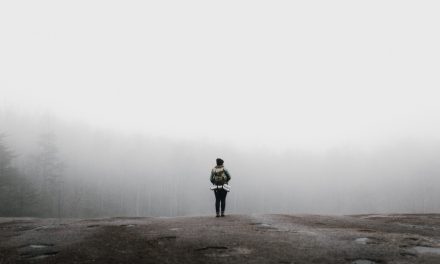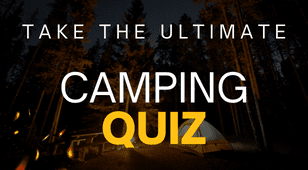It’s your first night out in the open wilderness, you have found a great site to set up camp and you are ready to get your first meal going. Other than reaching for the cold can of beans, you opt to reward yourself with a hearty meal. Campfire cooking is a timeless skill that connects you to nature as well as your camping buddies.
The tools
When you start camping, you may get carried away and want to bring your whole kitchen. However, these tools may be heavy and they will only weigh you down and take up precious space. Camping is about working in tandem with nature to make the most out of the little that you have.
You don’t need the latest grill and cookery set to reward your tastebuds. You can choose to go natural and use what you find. If you decide to use what nature provides, your best options will include firewood, digging a fire pit, or a makeshift grill. However, since it’s your first campfire feast, you should probably bring along a grill and a pan as backup! Don’t go full Bear Grylls mode until you have some experience.
Grill grates

A grill grate is the metal grill that can stand on its own over hot coals. This is one of the most versatile tools you can carry on your trip. It makes it easy to grill meats, fish, or even prepare a gourmet meal outdoors if you bring along a pot. The flat surface on the grates means you can adjust the right height by adding support rocks to make it a stable smoker.
The legs are foldable, so you can always pack it up and move to another site when you want. What makes it so diverse is that it is made out of hardy material so there is no need to worry about breakages or fire damage.
Overhead roasters
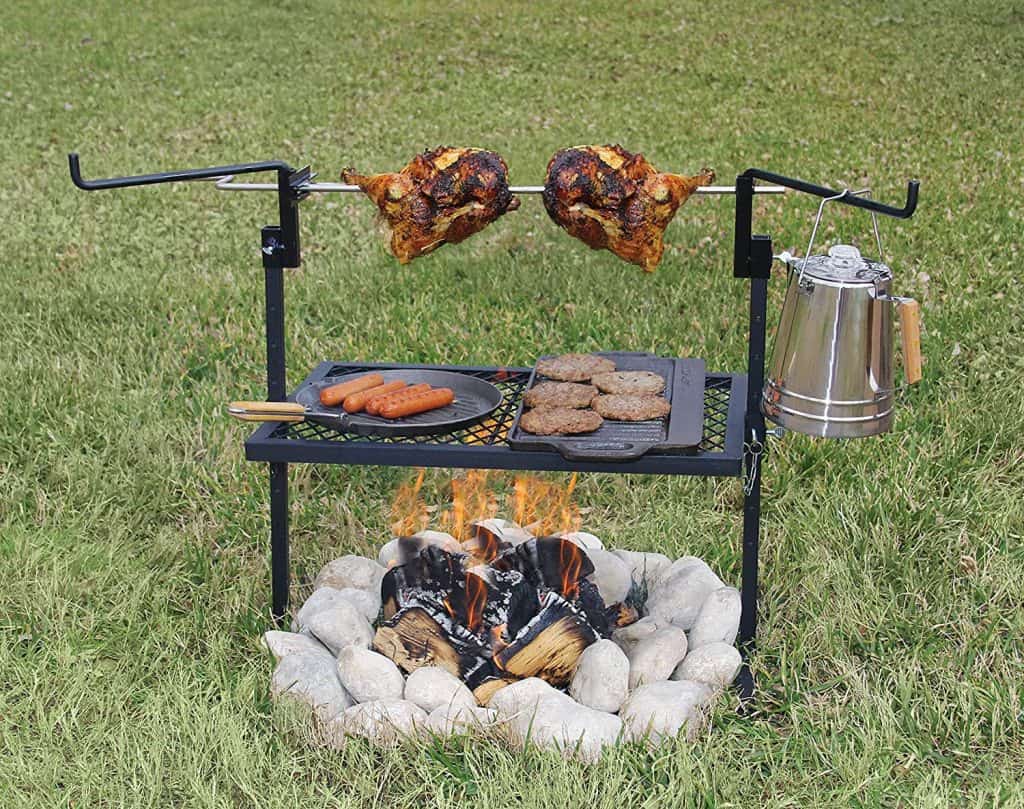
Gearing up for a hunting weekend in the woods? A rotisserie would be great for your first catch. It doesn’t need to be heavy. Two sturdy stands and a rod makes a nice setup to prepare smokey meat treats. You can also hang your kettles on the rod for your morning cup of joe. One of the major benefits of cooking using this tool is you can use the embers as warmers as you wait for your food to get ready.
Overhead roasters are a handful to carry around. Still, the benefits of hauling around this tool make a good case for it. Typically, they have sidearms that you can use to hang your pot meals and coffees. You can also set aside ready meals on the flat surface as the meat on the rod cooks. If you prefer slow cooking as you sing along to campfire tunes, this bad boy is as effective as any other modern tool.
The Adventure Kings rotisserie is quite popular among campers and fishermen, as well as the Texsport rotisserie shown above.
Activate Bush Mode
If you don’t fancy the idea of lugging around additional equipment, you need to know a few essentials of campfire cooking. This approach requires quick thinking and high adaptability. You’d need to set up camp early while daylight is still on your side. By night time, wildlife might start gathering near your campsite, putting you and your team in a tight spot.
Get a clear site
You need to select a clear spot that is free of any dry vegetation or easily flammable material. Be careful with the site you select. You shouldn’t start any fires that you don’t intend to use and put out.
The location of the fire should be farther from the sleeping area. One little misguided spark and you have to break out the emergency hammocks – and we don’t want that. The above area should also have a clearance high enough to make sure there won’t be any branches catching fire.
As some of you may already know, Smokey The Bear is the longest-running public service advertising campaign in U.S. history. His famous catchphrase plays an important role here: “Remember… Only YOU Can Prevent Forest Fires.”
Build your cooking area
Your cooking method guides your cooking area and the setup. Cooking areas that are specifically for meals require a hunter fire set up. A hunter fire needs two strong thick pieces of wood placed parallel to each other to form a V-shape. The smaller firewood is placed in the middle of the V. This method is perfect for hunted game and pot meals.
Make sure you position the ‘entrance’ in the direction from which the wind is blowing. This saves you the extra hassle of having to blow the fire to fan it. The Hunter’s fire lets you control the amount of fuel you use, the heat levels, and the duration of the fire. This level of control also determines whether you can slow cook or fast cook.
Alternatively, you can use the teepee method. The fire from this method will eventually become your campsite flame. You can do your post-feast singalongs around this campfire. You will need tinder, teepee, and fuelwood. The tinder-dry material such as leaves – goes first. It sets the base on which you start the fire. The teepee is made up of thin yet dry twigs and other materials that burn slower than tinder but faster than fuel. Finally, lay the fuelwood and add firewood in small increments according to how intense you want your fire to be.
Choose your food wisely
Here, you’re looking out for two levels of potential danger. Since it is outdoors, it’s easy to assume that you can cook anything. Well, that might be true. However, to avoid personal injury, and reduce the possibility of starting an accidental fire, avoid fatty foods. Fatty foods such as duck can create flare-ups that can be difficult to control. If you must cook fatty foods, make sure the fire area is free of any material likely to catch fire from a flare-up.
You can use a dutch oven to prevent accidental flare-ups. Deep iron skillets are great as well since they are made to handle the splash.
Are you going to be using stored meats? You’re out in the wild and possibly miles away from medical assistance. The last thing you want is a bad case of food poisoning. Leaving food out in the sun exposes it to bacteria. Meat is especially susceptible. If you hunt or fish, keep everything in ice until you need it. The same thing applies to cooked food. Bacteria start to reproduce after about 2 hours and are known to grow most rapidly in the range of temperatures between 40 °F and 140 °F.

Leftovers left in the sun have the potential to get you really sick. After your meal, gather any food material and trash. Put the trash in a bag for later disposal. Any food should be kept in a lockable box. It is then stored away from the sleeping area. This is supposed to keep out any animals from the sleeping site. Animals can be distractive and persistent when looking for food at night. Make sure your boxes are covered or well secured to prevent damage.
Put out the fire
No matter the size of your campfire, putting it out is as essential as the cooking process. Your camping troop does not need to be infamous for starting the fire that destroyed the woods. Putting out a fire requires preplanning. You will need about half an hour to properly put out the fire. You also need dirt or water beforehand.
Once you’re ready to retreat to your sleeping area, dig out a small pit. Sprinkle water until the fire is out. You can use dirt as well. Sprinkle lightly until there is no hissing or smoldering ember. Toss the embers with a rod or stick to make sure it touches some of the water. Run your hand above the extinguished site until you feel that it’s cool. Dispose of the ashes in the pit you made and cover the ground with the dirt. Pat the ground and even it out, leaving it as leveled and as clean as you found it.
How Do You Start a Fire?
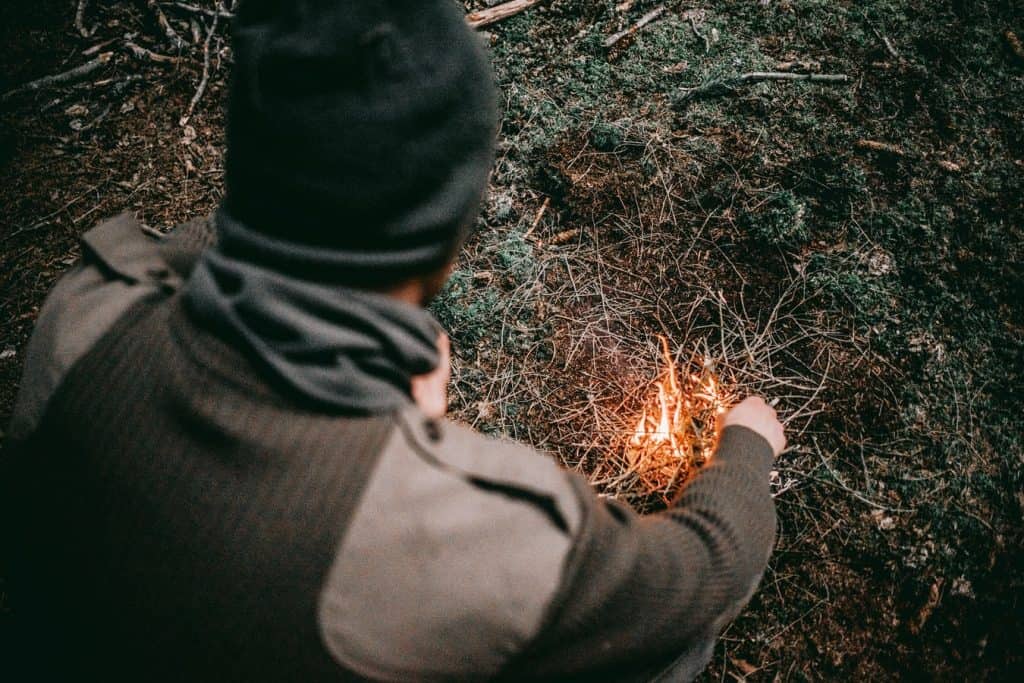
Since you’re smart and you carried all your fire-starting essentials, starting a fire is real easy. You either have matches, a lighter, or a handy fire starter. Still, you might forget to pack these basics in your rush and excitement for your camping trip. In other instances, the weather changes, and suddenly your pack of matches is turned into a soggy mess. You will need to improvise.
Lens fire
This is a time-tested method that has been used by campers all over. Eyeglasses and magnifying glasses work perfectly for this method. All you need is bright sunshine and dry tinder. Focusing the sun’s light on the tinder starts a slow fire. You need to fan it as you add light material on top to feed the fire.
There are other non-conventional ways that work on the same principle. During the cooler months such as winter, clear ice is used as a lens to create fire. You need to shape the ice by warming the rough edges. This method will not work using cloudy ice. The best option is to make sure you have a 2-inch thick block of clear ice.
Friction
Friction-based methods are more demanding. They need patience and a lot of elbow grease. You also need to find bone-dry wood to make these methods work. Some of the most dated methods include creating a trough in dry wood and rubbing a thinner piece of wood in the trough until it creates some heat. You need to feed the heat with dry material before adding heavier wood to sustain the fire.
Alternatively, you can use flint and steel to create sparks. The friction created by striking the flint against the steel causes sparks that ignite the char at the base of the fire. However, if you’re in the woods and you don’t have char, birch will work.
One of the quickest yet energy-intensive friction methods involves a drill and bow. Fashion a bow from strong bendy wood. Fasten a cord on both ends, with a wooden drill in the middle. Make sure any material you use as a cord can’t break easily. Hold the drill in place with a socket. The socket is a piece of wood or stone on which you apply pressure to ease the effort applied to the drill. It needs to be wet or oily, otherwise, it will catch fire as well.
Create a small depression on the fireboard and put tinder under it. Some of the tinder should also stick out, almost touching the depression. Spin the drill into the fireboard using the bow until you create an ember. Your back and forth motion needs to be lightning-fast to make this work faster.
Okay, So What Should You Cook?

Your culinary choices heavily influence the tone and overall experience of your camping trip. Knowing the right foods to pack in the first place will enhance your food choices and influence your cooking methods.
Your activities while camping will also play a big part in what you eat. If you intend to throw in hiking, nature trails, or energy-draining activities during your trip, high protein foods will keep you energized. If you’re vegan, we also have some awesome food ideas.
Crackers
Crackers are a great base to have with most soup-based meals. They stay fresh for long and you can have them on their own to replenish your energy reserves. You don’t know what you might catch if you decide to go hunting or finish. However, you can always bank on crackers to pair well with any stew you cook up.
Canned foods
Is it really camping without a hearty plate of hot beans? Canned foods such as lentils, beans, and canned fruit are a superb choice to include in your food plan. Beans and fruit are not only packed with nutrients, but they make a quick and easy meal. They stay fresh as long as you keep them well preserved.
Still, if you have the correct cooking equipment, you can boil dry beans from scratch and tweak your meals to your preference.
Meat and fish
Some of the most memorable meals you will have on your first camping trip will involve meat or fish. If you are doing it as a group, a barbeque can be a bonding session as well. The beauty of this is you don’t have to bring your own meat or fish. Look for a river or hunt for game nearby. The day’s catch should make for a special time when it hits the pot and the plate later.
With the right cooking tools, you can make entire meal plans based on the meat and fish you packed. However, stick to cooking methods that don’t require oil. This is to prevent you from accidental flare-ups and to reduce your load. Some cuts of meat have enough fat to cook through.
Vegetable soups
We bet you never saw yourself incorporating vege-packs into your camping dietary checklist. If you are camping out, especially during the cold months, you will love the warmth of hot vegetable soup by the campfire. This is not only a health-conscious choice. It is also a way to diversify your feeding choices and a chance to maintain that feels-like-home aura while away from home.
Vegetables can be pre-frozen and cooked on demand. They make great pairings with meat and fish. You also get to enjoy a balanced diet while you are out in the wild. If you have any person in your camping party that doesn’t eat meat or fish, they won’t have to miss out on account of the food choices. If you know your way around the forest, identify edible roots and give them a try. However, keep a keen eye out for any greens that might harm you.
Processed meats
There we go with the meats again. Processed meats such as sausages are great for campfire cooking. They’re a tasty treat when they’re grilled or skewered and cooked on open flames. They can also be served as snacks in between meals. If you don’t have any vegetables or raw meat, processed meats such as sausage can be mixed with dry food to make meals.
Cup noodles
Sometimes you just need a quick fix. Noodles make a delicious fix that you can have on your camping trip. All you need is hot water and you have a filling meal. You can even mix it up with other foods and you have a full course meal. As a dry food, noodles can act as a survival pack if you are planning for a long camping trip.
Snacks
Singalongs and cooking are a camping staple. Marshmallows, trail mix, jerky, and fruit cups are great fillers. Marshmallows can be roasted on an open fire. The rest of the snacks don’t need any cooking. They also don’t leave a mess afterward.
Instant coffee and tea bags
Wake up to a fresh cup of coffee and wind up your day with a hot cup of tea. Instant coffee and tea are an essential part of most people’s day. You can also carry beans and a grinder if you prefer to have stronger coffee.
Campfire cooking makes great memories. You can come up with creative recipes and experiment with different food groups even as you camp. Adhering to camping rules makes your camping trips worth it.
- The 5 Best Heated Vests of 2022 - November 17, 2022
- 5 Best Campfire Cooking Tripods in 2021 - October 20, 2020
- 5 Best Camping Generators (Buying Guide) In 2022 - October 9, 2020

